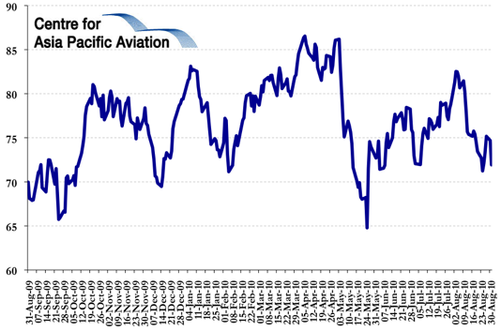Oil recovers from seven-week low but price uncertainty continues – Friday Fuel Watch
Oil prices continued to see-saw this week, as better manufacturing data from China and higher oil demand in Asia offset more signs that the US economic recovery is faltering. At the end of Aug-2010, US Federal Reserve Chairman, Ben Bernanke, attempted to sooth concerns about the pace of US growth, after the US government reported 2Q2010 GDP expanded by just 1.6%.
Mr Bernanke confirmed that the Federal Reserve would continue to take steps to boost growth, including "unconventional" measures, and that there are still prospects for a pick-up in growth in 2011.
Oil prices hit an eight-week low of USD71.24 per barrel before recovering through the week and then dropping back below USD72 per barrel again.
US crude oil inventories continue to rise well above market expectations. However, gasoline consumption is increasing, a positive economic sign. Distillate stocks are also declining, contrary to analysts expectations. US refinery capacity has eased slightly, down to 87%, a fall of 0.7 percentage points.
Saudi Aramco forecast late last week that the price of oil may end the year above USD82 per barrel, driven by demand from China and India. The Saudi state oil company has also pushed aside concerns about peak oil, pegging oil and natural gas reserves at 13 trillion-15 trillion barrels, including 6 trillion-8 trillion barrels of conventional or easily obtainable fossil fuels (oil and natural gas). Known oil reserves around the world are estimated at 1.3 trillion-1.4 trillion barrels. Saudi Arabia produced 3.4 billion barrels of oil last year, against known reserves in the country of 266 billion barrels.
Saudi Arabia estimates that peak oil production will not be reached until around 2020, a figure that is something of a moving target, as alternative technologies and biofuels become increasingly viable. However, a study produced by a German research group on behalf of the Bundeswher, and leaked earlier this week, estimates that peak oil could occur as early as the end of the year. The report also posits a scenario following peak oil of a reduction of free market mechanisms in oil trade and a rise in more exclusive bilateral exchange deals, renewed protectionism and political alliances between oil suppliers and their major customers.
WTI spot price (USD per barrel): Aug-2009 to Aug-2010
Daily jet fuel prices (kerosene, cents per gallon) at New York, US Gulf Coast, Los Angeles, Amsterdam, Singapore: Aug-2009 to Aug-2010
Daily jet fuel prices (kerosene, cents per gallon) at New York, US Gulf Coast, Los Angeles, Amsterdam, Singapore vs Crude Spot price (WTI, USD per barrel): 24-Aug-2010 to 31-Aug-2010-2010
|
24-Aug-10 |
25-Aug-10 |
26-Aug-10 |
27-Aug-10 |
30-Aug-10 |
31-Aug-10 |
one week Change |
12 month Change |
|
|---|---|---|---|---|---|---|---|---|
|
New York Harbor |
202.3 |
206.58 |
209.25 |
213.68 |
209.67 |
204.75 |
1.2% |
12.6% |
|
U.S. Gulf Coast |
198.23 |
202.4 |
205.39 |
209.82 |
205.92 |
201 |
1.4% |
12.9% |
|
Los Angeles |
200.55 |
208.4 |
209.89 |
215.07 |
211.01 |
206 |
2.7% |
13.0% |
|
199.72 |
203.88 |
205.76 |
211.51 |
207.65 |
205.46 |
2.9% |
13.0% |
|
|
197.86 |
198.69 |
201.07 |
202.26 |
205.48 |
203.69 |
2.9% |
10.7% |
|
|
WTI Spot* |
71.24 |
72.07 |
73.36 |
75.17 |
74.69 |
71.93 |
1.0% |
2.8% |

